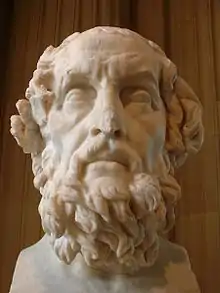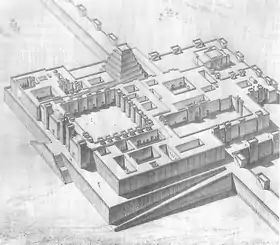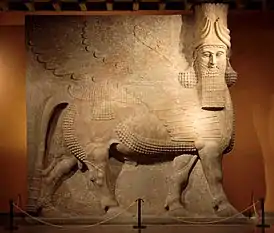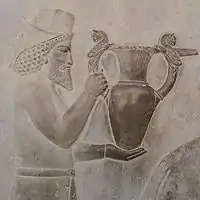Древний мир
Дре́вний мир — период в истории человечества, выделяемый между доисторическим периодом и началом средних веков в Европе[1]. В других регионах временные границы древности могут отличаться от европейских. Например, концом древнего периода в Китае иногда считают появление империи Цинь[2], в Индии — империи Чола[3][4][5], а в Америке — начало европейской колонизации[6].

Термин «классическая древность» (или античность) обычно относится к греческой и римской истории, которая начинается от первой Олимпиады (776 до н. э.). Эта дата почти совпадает с традиционной датой основания Рима (753 до н. э.). Датой окончания европейской древней истории обычно считают год падения Западной Римской империи (476)[7][8], а иногда — дату смерти императора Юстиниана I (565)[9], появления ислама (622)[10] или начало правления императора Карла Великого (800)[11].
В то же время в российской историографии используется термин Древнерусское государство по отношению к истории Руси Средних веков.
Периодизация
- Доисторический период — каменный век (палеолит, мезолит, неолит). Самыми значительными событиями этого времени были установление современного климата в мезолите, одомашнивание животных и освоение культурных растений в неолите.
- Бронзовый век. Освоение человеком металла. Сначала это была медь (медный век — халколит или энеолит), а после была изобретена бронза (сплав меди и олова). В эту эпоху создаётся письменность, появляются первые письменные памятники. Главные государства этого времени: Египет, Шумер, Аккад, Хеттское царство (Хатти), Митанни, Хайаса.
- В конце 2-го тысячелетия до н. э. на Ближнем Востоке наступает кризис бронзового века, который становится переходным этапом к железному веку.
- Железный век. Освоение технологии выплавки железа, этот металл стал широко доступен и значительно расширил возможности людей. Главными государствами этого времени были Араратское-Ванское царство (Урарту), Ассирийское царство, Израильское царство, Персидская империя, Древняя Греция и Древний Рим, Великая Армения. В конце железного века происходил процесс зарождения христианства.
Страны и народы Древнего мира
Средиземноморье и Ближний Восток
- Адиабена
- Айраратское царство
- Аккад
- Аксумское царство
- Аласия
- Амурру
- Арахозия
- Ассирия
- Атропатена
- Бактрия
- Боспорское царство
- Британия
- Вавилония
- Великая Армения
- Вифиния
- Галатия
- Галльская империя
- Гарамантида
- Гиркания
- Государство Сасанидов
- Дакия
- Диаоха
- Дʿмт
- Древняя Греция
- Древний Египет
- Древняя Македония
- Древний Рим
- Забаха
- Иберия
- Иллирия
- Иудейское царство
- Израильское царство
- Ишкуза
- Кавказская Албания (Алуанк)
- Каппадокия
- Карфаген
- Катабан
- Колхида
- Коммагенское царство
- Куш (Нубия)
- Кушанское царство
- Лазика
- Лидия
- Малая Армения
- Манна
- Мидия
- Митанни
- Набатея
- Нумидия
- Осроена
- Палестина (Ханаан)
- Парфия
- Пергамское царство
- Персия
- Понт
- Сабейское царство
- Северное Израильское царство
- Селевкидская империя
- Скифия
- Согдиана
- Софена (Цопк)
- Субарту
- Тартесс
- Троя
- Урарту
- Фракия
- Финикия
- Фригия
- Халдея
- Хайаса
- Хеттское царство
- Химьяр
- Хорезм
- Шумер
- Эбла
- Элам
- Эпирское царство
- Этрурия
- Ямхад
Южная и Восточная Азия
Америка
Народы Древнего мира


- Амалекитяне
- Амореи
- Арабы
- Арамеи
- Армяне
- Ассирийцы
- Бактрийцы
- Галлы
- Германцы
- Гиксосы
- Греки
- Грузины (Иверы)
- Гунны
- Даки
- Евреи
- Египтяне
- Енисейские кыргызы
- Иллирийцы
- Кавказские албаны
- Кельты
- Киммерийцы
- Китайцы
- Кушаны
- Латины
- Лидийцы (Меоны)
- Македоняне
- Мидийцы
- Набатеи
- Народы моря
- Парфяне
- Персы
- Римляне
- Сарматы
- Саки
- Скифы
- Согдийцы
- Сяньби
- Тохары
- Усуни
- Финикийцы
- Фракийцы
- Фригийцы
- Халдеи
- Халибы
- Хананеи
- Хатты (Анатолия)
- Хетты
- Хорезмийцы
- Хунну
- Хурриты
- Шумеры
- Эфиопы
- Эламиты
- Этруски
- Эфталиты
Войны древнего мира

- Захватнические походы древних государств с целью порабощения племён, находившихся на более низкой стадии общественного развития, сбора дани и захвата рабов (например, Галльская война, Маркоманская война и др.);
- Межгосударственные войны с целью захвата территорий и ограбления завоёванных стран (например, Пунические войны, Греко-персидские войны);
- Гражданские войны между различными группировками аристократии (например, войны диадохов за раздел империи Александра Македонского в 321—276 до н. э.);
- восстания рабов (например, восстание рабов в Риме под руководством Спартака);
- народные восстания крестьян и ремесленников (восстание «Краснобровых» в Китае).
См. также
Примечания
- История Древнего мира в 3 т., Издание третье / Ред. И. М. Дьяконова, В. Д. Нероновой, И. С. Свенцицкой — М.:Издательство «Наука», 1989.
- Gernet, J. (1996). A history of Chinese civilization. Cambridge: Cambridge University Press.
- Elphinstone, M. (1889). The history of India. London: Murray.
- Smith, V. A. (1904). The early history of India from 600 B.C. to the Muhammadan conquest, including the invasion of Alexander the Great. Oxford: Clarendon Press.
- Hoernle, A. F. R., & Stark, H. A. (1906). A history of India. Cuttack: Orissa mission Press.
- Priest, J. (1834). American antiquities, and discoveries in the West: being an exhibition of the evidence that an ancient population of partially civilized nations, differing entirely from those of the present Indians, peopled America many centuries before its discovery by Columbus, and inquiries into their origin, with a copious description of many of their stupendous works, now in ruins; with conjectures concerning what may have become of them; compiled from travels, authentic sources, and the researches of antiquarian societies. Albany: Printed by Hoffman & White
- Clare, I. S. (1906). Library of universal history: containing a record of the human race from the earliest historical period to the present time; embracing a general survey of the progress of mankind in national and social life, civil government, religion, literature, science and art. New York: Union Book. Page 1519 (cf., Ancient history, as we have already seen, ended with the fall of the Western Roman Empire; […])
- United Center for Research and Training in History. (1973). Bulgarian historical review. Sofia: Pub. House of the Bulgarian Academy of Sciences]. Page 43. (cf. … in the history of Western Europe, which marks both the end of ancient history and the beginning of the Middle Ages, is the fall of the Western Empire.)
- Robinson, C. A. (1951). Ancient history from prehistoric times to the death of Justinian. New York: Macmillan.
- Breasted, J. H. (1916). Ancient times, a history of the early world: an introduction to the study of ancient history and the career of early man. Boston: Ginn and Company.
- Myers, P. V. N. (1916). Ancient history. New York [etc.]: Ginn and company.
- University of Oxford. Classical Armenian Studies Архивная копия от 18 января 2011 на Wayback Machine
- Livius. Articles on Ancient History (недоступная ссылка). Дата обращения: 22 сентября 2010. Архивировано 14 мая 2011 года.
Ссылки
- Под ред. Е. М. Жукова. Древний мир // Советская историческая энциклопедия. — Советская энциклопедия. — М., 1973—1982. // СИЭ / Ю. П. Францев
- История древнего мира
- История древнего мира
- Сайт «Древний мир»
- Неолит Северной Африки — Neolithic north Africa (англ.)
- ДЕМОГРАФИЯ ДРЕВНЕГО МИРА
